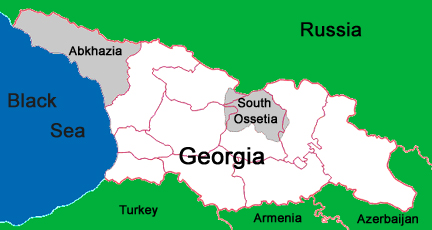Background: South Ossetia/Georgia
A mountainous region torn between Georgia and Russia
Article published on the 2008-08-11 Latest update 2008-08-16 12:42 TU
The region is no stranger to the clash of interests between its neighbours, as a look at its history shows:
1783: Russian Empress Catherine the Great and her favourite Prince Potemkin send troops into the Caucausus; the Russians encounter little resistance from the Ossetians but more from the Georgians and other ethnic groups.
1812: Popular rebellion aginst Russian rule in Georgia and Ossetia is put down by Moscow's troops.
1844: Russia dispatches a force to put down rebellion in the Caucasus led by Chechen rebel Imam Shamil; Ossetians generally fight on the Russian side in continuous fighting thoughout the century.
1918-1920: Uprisings in what is now South Ossetia against republics set up after the Russian revolution which opposed the newly-established Soviet Union.
1921-1922: The Red Army invades Georgia; the Soviet Union declares South Ossetia an autonomous oblast (administrative district) within the new Transcaucasian Republic; allowing local control over matters such as language and education.
1988: Formation of the South Ossetian Popular Front in response to mounting Georgian nationalism.
1989: As a crisis that will become terminal hits the Soviet Union, the Popular Front comes to power and demands that the oblast become an autonomous republic; the Georgian government rejects the call; protests and demonstrations on both sides.
1990: North Ossetia becomes part of Russia; a South Ossetian declaration of independence is rejected by Georgia; Georgian President Zviad Gamzakhurdia abolishes autonomous status, declares a state of emergency in the region and bans political parties there during a parliamentary election; Georgia sends in troops when the South Ossetian legislature tries to secede and join North Ossetia.
1992: After thousands of casualties and the flight of tens of thousands of refugees, a ceasefire is mediated by Russian President Boris Yeltsin; the agreement sets up a security corridor, creates the Joint Control Commission and the Joint Peacekeeping Forces, consisting of Georgian, Ossetian and Russian troops.
2001: An unrecognised presidential election is won by former communist wrestler-turned-entrepreneur Eduard Koltoi, or Kokoyev.
2003: Georgia's so-called "Rose Revolution" drives Eduard Shevardnadze out of power, to be replaced by Mikheil Saakashvili, a US-trained lawyer who advocates reducing Russian influence in the region.
2006: South Ossetians vote again for independence from Tbilisi in a referendum which is not recognised by the rest of the world; a simultaneous referendum among the region's Georgian population rejects the idea; Koltoi is re-elected in another unrecognised vote; the second-longest pipeline in the world is completed to link the oil-rich Caspian Sea to the Turkish port of Ceyhan, passing through Georgia without passing through Russia or Iran.
2007: Saakashvili resigns as president to face a new election.
2008: Saakashvili is re-elected in January; On 8 August Georgia sends troops into South Ossetia, Russia responds.





